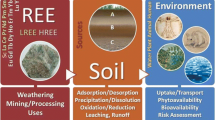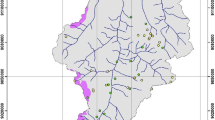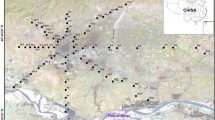Abstract
Investigation on the behavior of elements in the soil is important both in exploration and environmental geochemistry studies. Rare earth elements (REEs) are the most useful among all trace elements. REE studies have shown that they have important applications in igneous, sedimentary, and metamorphic petrology. This work aims to investigate the relationship of these elements with one another and the behavior of the major oxides and trace elements with REEs. Soil samples were obtained from the alteration site possibly related to mineralization and were analyzed for major oxides, trace elements, and REEs. The relationships between the major oxide–trace element/heavy metal and REE were investigated by statistical methods, such as descriptive statistics, correlation coefficient, and principle component analysis. According to the correlation coefficient matrix, light REEs (LREEs) showed weak to moderate negative correlation with MgO and MnO and moderately positive correlation with SiO2 and K2O. No association was detected between the heavy REEs (HREEs) and the main oxides, but a strong positive correlation with LREEs was observed. For the trace elements, LREE showed a weak positive correlation with Ba and Sn and moderate to strong positive correlation with As, Hf, Nb, Rb, Ta, Th, U, W, and Zr. They also displayed weak to moderate correlation with Sc, Co, Zn, Ni, and V. HREE showed weak to moderate positive correlation with Ni, Cs, Ga, Hf, Th, Zr, As, and LREE. Although REEs exhibited no direct correlation with Au and Ag, they showed a good correlation with some trace elements that are related to hydrothermally altered products. This study showed that REEs can also be used in exploration and environmental geochemistry studies by exploiting the relationship between REEs and other trace/heavy metal elements.





Similar content being viewed by others
References
Güner, S., Yazıcı, E., Dursun, Ö., & Akyürek, S. (2012). Gümüşhane-Demirören Sahasının Maden Jeolojisi Raporu. Ankara.
Kaiser, H. (1960). The application of electronic computers to factor analysis. Educational and Psychological Measurement, 20, 141–151.
Kandemir, R. (2004). Gümüşhane ve Yakın Yörelerindeki Erken-Orta Jura Yaşlı Şenköy Formasyonu’nun Çökel Özellikleri ve Birikim Koşulları. Trabzon.
Karsli, O., Chen, B., Aydin, F., & Şen, C. (2007). Geochemical and Sr-Nd-Pb isotopic compositions of the Eocene Dölek and Sariçiçek Plutons, Eastern Turkey: Implications for magma interaction in the genesis of high-K calc-alkaline granitoids in a post-collision extensional setting. Lithos, 98, 67–96. https://doi.org/10.1016/j.lithos.2007.03.005.
Miranda, J., Andrade, E., Lopez-Suarez, A., et al. (1996). A receptor model for atmospheric aerosols from a southwestern site in Mexico City. Atmospheric Environment, 30, 3471–3479. https://doi.org/10.1016/1352-2310(95)00477-7.
Morey, G. B., & Setterholm, D. R. (1997). Rare earth element in weathering profiles and sediments of Minnesota: Implications for provenance studies. Journal of Sedimentary Research Section, 105–115.
Nesbitt, H. W. (1979). Mobility and fractionation of rare earth elements during weathering of a granodiorite. Nature, 279, 206–210.
Nowak, B. (1998). Contents and relationship of elements in human hair for a non-industrialized population in Poland. Science of the Total Environment, 209, 59–68.
Pelin, S. (1977). Alucra (Giresun) Güneydoğu yöresinin petrol olanaklan bakımından jeolojik incelemesi. Trabzon: Karadeniz Teknik Üniversitesi Yayını.
Rose, A. W., Hawkes, H., & Webs, J. (1991). Geochemistry in mineral exploration (2nd ed.). London: Academic.
Sungur, A., Soylak, M., Yilmaz, E., Yilmaz, S., & Ozcan, H. (2014). Characterization of heavy metal fractions in agricultural soils by sequential extraction procedure: The relationship between soil properties and heavy metal fractions. Soil and Sediment Contamination, 24, 1–15.
Sungur, A., Soylak, M., & Ozcan, H. (2015). Investigation of heavy metal mobility and availability by the BCR sequential extraction procedure: relationship between soil properties and heavy metals availability. Chemical Speciation and Bioavailability, 26(4), 219–230.
Topuz, G., Altherr, R., Schwarz, W. H., et al. (2007). Variscan amphibolite-facies rocks from the Kurtoǧlu metamorphic complex (Gümüşhane area, Eastern Pontides, Turkey). International Journal of Earth Sciences, 96, 861–873. https://doi.org/10.1007/s00531-006-0138-y.
Unsal, Y. E., Tuzen, M., & Soylak, M. (2014). Evaluation of metal concentrations of soil samples from Yahyali-Kayseri, Turkey. Fresenius Environmental Bulletin, 23(1), 1–15.
Vural, A. (2013). Demirören (Gümüşhane) Altın Zenginleşme Sahasında Toprak ve Bitki Jeokimyası Çalışması. Project Report.
Vural, A. (2015). Contamination assessment of heavy metals associated with an alteration area : Demirören Gumushane , NE Turkey. Journal of the Geological Society of India, 86, 215–222.
Vural, A. (2016). Demirören (Gümüşhane) Fe-Skarn Yatağının Jeolojik, Jeokimyasal ve Köken Özellikleri Açısından İncelenmesi. Project Report.
Yılmaz, Y. (1972). Petrology and structure of the Gümüşhane granite and surrounding rocks, NE Anatolia.
Acknowledgments
The author would like to thank Sebahattin Güner (Mineral Research and Exploration of Turkey, MTA) and Ferkan Sipahi (Gümüşhane University) for their contributions and Narin Ciftcier-Güran and Murat Erdoğan for their assistance in field and laboratory studies. The author also thanks to the editor and the anonymous reviewers for their improvement of the manuscript.
Funding
The study was supported by the Scientific Research Coordinator of Gümüşhane University (GÜBAP, Grant no. 13.F5114.02.2).
Author information
Authors and Affiliations
Corresponding author
Additional information
Publisher’s note
Springer Nature remains neutral with regard to jurisdictional claims in published maps and institutional affiliations.
Rights and permissions
About this article
Cite this article
Vural, A. Investigation of the relationship between rare earth elements, trace elements, and major oxides in soil geochemistry. Environ Monit Assess 192, 124 (2020). https://doi.org/10.1007/s10661-020-8069-9
Received:
Accepted:
Published:
DOI: https://doi.org/10.1007/s10661-020-8069-9




